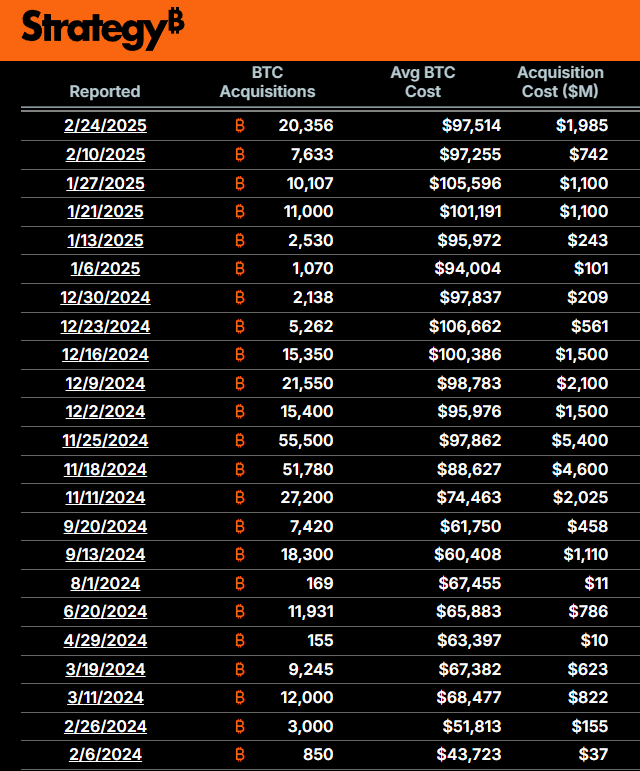TGIF Dispatchers.
It’s August 2020. You are Michael Saylor and the pandemic has locked you in your Miami waterfront estate. MicroStrategy has $500 million in cash reserves, but the Fed's money printers are humming at unprecedented rates. Inflation isn't merely coming anymore, it's now at your doorstep.
Your options: keep the cash safe in Treasuries, diversify into traditional assets, or convert half of it into this digital money experiment called Bitcoin.
You choose the last option.
Within weeks, your company loses $40 million on paper as Bitcoin's price drops from $11,000 to $9,000. Your board is nervous. You've lost money before, haven't you?
Four years later, that $250 million investment is worth nearly $50 billion, and you've engineered what traders call an "infinite money glitch" that transformed a forgotten software company into an $65 billion+ Bitcoin powerhouse.
This is the story of the man who bet everything on Bitcoin — and so far, is winning.
Stake Smarter, Stay Liquid – with Marinade Finance!
Why choose between earning staking rewards and keeping your SOL accessible? With Marinade Finance, you get the best of both worlds.
Stake SOL in seconds & earn rewards effortlessly
Stay liquid with mSOL—use it across Solana DeFi
Non-custodial & secure—your assets remain yours
Boost Solana’s security while maximising your yield
No lockups, no waiting—just smarter staking designed for flexibility and growth. Whether you're a DeFi pro or just getting started, Marinade makes staking seamless and rewarding.
Stake your SOL today with Marinade Finance!
The Man Who Lost $6 Billion in a Day
In March 2000, the New York Daily News ran a headline that would have sent most executives spiralling into obscurity: "Lost $6 Billion in a Day." The photo showed a shell-shocked 35-year-old Michael Saylor, then CEO of MicroStrategy, looking like he'd been blindsided by a financial asteroid.
And he had been. MicroStrategy's shares continued to plunge in the ensuing dotcom meltdown, eventually bottoming at 45 cents — down from a high of $313. Saylor's once-promising company became a cautionary tale of dotcom hubris.
Except that the devastating crash wasn't the end of Michael Saylor's story.
It was merely the first act.
Get 17% discount on our annual plans and access our weekly premium features (HashedIn, Wormhole, Rabbit hole and Mempool) and subscribers only posts. Also, show us some love on Twitter and Telegram.
From Cockpit to Coding
Born in 1965 to an Air Force chief master sergeant, young Michael spent his childhood bouncing between military bases around the world.
In 1983, Saylor secured an Air Force ROTC scholarship to MIT, where he pursued a peculiar double major: aeronautics and astronautics paired with science, technology, and society.
It was at MIT that Saylor met Sanju Bansal, with whom he would later co-found MicroStrategy in 1989. The company initially focused on data mining and business intelligence, offering corporations tools to make sense of their growing mountains of information.
Early success came in 1992 with a $10 million deal with McDonald's. By 1998, MicroStrategy went public, and within two years, Saylor's net worth had ballooned to $10 billion. He celebrated with lavish parties and Caribbean cruises for employees, buying domain names like Hope.com and Voice.com (later sold for $30 million).
Then came the crash.
The Wilderness Years
After the dotcom collapse and the subsequent $11 million settlement with the US Securities and Exchange Commission (SEC) over accounting fraud charges (which Saylor neither admitted nor denied), MicroStrategy shares plummeted to 45 cents by July 2002, down from a high of $313.
At lunch with venture capitalist Rick Rickertsen in the Hamptons, Saylor was asked if he worried about losing his business.
"I might," he replied. "But I'll just start something new."
That resilience proved crucial. Saylor restructured MicroStrategy's debt and executed a 10-for-1 reverse stock split, averting disaster. The company survived, but its stock barely moved for years. By 2020, MicroStrategy was worth just $1.5 billion — profitable but stagnant, with about $500 million in cash.
"The company was going nowhere, it had almost no Wall Street following," recalls Rickertsen, who had become a board member. "It was bleak."
In those wilderness years, Saylor personally invested in rising tech stars like Google and Apple, but remained dismissive of cryptocurrencies. In 2013, he infamously tweeted that Bitcoin's "days are numbered."
He couldn't have been more wrong — or farther away from prophecising his future.
The Pandemic Pivot
While quarantined in his Miami estate during the 2020 pandemic, Saylor wrestled with a problem: what to do with MicroStrategy's $500 million cash reserve in an era of looming inflation?
After studying Bitcoin anew, the man who once predicted its demise became its most fervent convert. In August 2020, Saylor convinced his board to spend $250 million — half the company's cash — to buy Bitcoin at around $11,000.
He went all in personally too, adding over $100 million of his money to the digital currency.
The immediate result? Bitcoin promptly tumbled to $9,000, costing MicroStrategy about $40 million on paper.
That anxiety was short-lived. Bitcoin finished 2020 above $26,000, and a new Michael Saylor was born — the Bitcoin evangelist who would ultimately rebrand his company from MicroStrategy to simply "Strategy."
Read: MicroStrategy Drops the ‘Micro’ 🎤
The Zero-Interest Magic
What makes Saylor's Bitcoin acquisition strategy particularly remarkable isn't just its size or conviction, but its financial engineering.
Most corporate stories about Bitcoin revolve around cautious experimentation: add a small percentage to the treasury, announce it with fanfare, observe the market reaction. What makes Saylor's approach so jarring is the complete absence of half-measures.
Since August 2020, when Strategy first converted $250 million of its cash reserves into Bitcoin, Saylor has been executing what some called an “infinite money glitch”.
Issue convertible notes at near-zero interest rates (0.625% to 2.25%)
Use the proceeds to buy Bitcoin
Watch Strategy's stock premium rise on Bitcoin enthusiasm
Use the inflated stock price to issue more debt
Repeat
Read: Saylor Strategy: 0️⃣ Interest, ♾️ Bitcoin?
No Signs of Slowing Down
On March 10, the company announced plans to raise up to $21 billion in fresh capital to purchase more BTC through its "ATM Program" - a sales agreement that would allow it to issue and sell shares of its 8% Series A perpetual strike preferred stock.
This move is part of Strategy's ambitious "21/21 plan" - a strategy to raise $42 billion over the next three years, split evenly between equity and fixed-income securities, all dedicated to acquiring more Bitcoin.
The company has been aggressively executing this vision. In February 2025, Strategy purchased 20,356 Bitcoin for $1.99 billion at an average price of $97,514 per token, bringing its total holdings to approximately 499,096 BTC - worth over $41 billion and acquired at an average price of $66,423 per coin.
This year alone Strategy has purchased BTC six times. In 2024? 17 times.
"We're making $500 million a day. I'm staring at my screen, and we're selling dollar bills for $3, sometimes a million times a minute," Saylor told CNBC in November.
The elegance of Saylor's approach is that it creates a self-reinforcing cycle during bull markets: Bitcoin rises, Strategy's stock rises more (due to leverage), which makes it easier to issue more debt or equity to buy more Bitcoin. As long as Bitcoin trends upward over time, the model works brilliantly.
The risk, of course, is what happens if Bitcoin enters a prolonged bear market or interest rates rise substantially. The music hasn't stopped yet, but some analysts worry about what happens when it does.
The $200 Trillion Vision
Saylor's Bitcoin ambitions extend far beyond personal or corporate wealth. He envisions a future where Bitcoin's market cap explodes from its current $2 trillion to $200 trillion, driven by capital flowing from China, Russia, Europe, Africa, and Asia.
This would value a single Bitcoin at approximately $10 million.
Even more striking is his proposal for a US Strategic Bitcoin Reserve. He suggests that if the United States were to secure 10-20% of the Bitcoin network (roughly 2-4 million BTC), it could significantly reduce the national debt.
"If the United States takes a position in the emerging crypto economy, if it buys up 10, 20% of the Bitcoin network, we're going to pay off the national debt. And so why wouldn't that be in the interest of the United States?" Saylor argued in a recent CNBC interview.
Saylor's influence now extends to Washington DC, where he's been meeting with the SEC's Crypto Task Force to discuss regulatory reforms, and potentially with President Donald Trump’s administration, which has signed executive orders to create a US Crypto Strategic Reserve and a Bitcoin Strategic Reserve.
The Premium Problem
For all its apparent success, Strategy's approach presents investors with a conundrum: its shares trade at a premium to its Bitcoin holdings' value. Based on the latest figures, with a market cap of $67.97 billion and Bitcoin holdings worth $40.95 billion, investors are effectively paying a premium of approximately 67% for Bitcoin exposure through Strategy shares.
This NAV premium of 1.67x (or $170.06 per share at 240.78 million shares) represents the market's assessment of several factors:
The perceived value of Saylor's financial engineering
The option value of future Bitcoin purchases
The scarcity of publicly-traded, Bitcoin-focused companies
This premium also carries a significant risk. If Bitcoin experiences a sustained downturn, if interest rates rise sharply, or if competitor Bitcoin investment vehicles proliferate, this premium could rapidly contract.
Critics point out that after the entry of spot Bitcoin ETFs, retail and institutional investors now have far more efficient ways to gain Bitcoin exposure without the Saylor premium. Why pay a significant premium for Bitcoin wrapped in corporate complexity when you could simply buy a Bitcoin ETF? There's also the "key man risk" — the strategy is heavily dependent on Saylor with no clear succession plan.
If something were to happen to him, it's uncertain whether the company could maintain its current trajectory. The current stock performance tells a complex story. While Strategy shows a 23.6% all-time gain on its Bitcoin holdings, the stock price has been more volatile than the underlying asset.
The saylortracker.com chart shows the cycles of Bitcoin's price alongside Strategy's purchasing pattern. Notably, the recent market correction has brought Bitcoin down from highs above $100,000 to around $82,000, testing investors' resolve.
These concerns may explain why Strategy's stock has fallen 35% since Saylor appeared on the Forbes cover in late January 2025, dropping from $340.09 to $238.25 by March 10 and $263 as of now.
Yet institutions continue to pour money into Strategy:
Vanguard: $2.6 billion
BlackRock: $2.1 billion
Total institutional holdings: $15.3 billion
This institutional backing suggests that while retail investors may be getting nervous, big money still sees value in Saylor's approach — or perhaps they're simply trapped in positions too large to easily exit.
Read: Has Saylor’s BTC Strategy Hit a Block? ⛔️
Token Dispatch View 🔍
The mad genius paradox. The history of innovation is littered with figures who were ridiculed before they were revered. From the Wright brothers to Steve Jobs, those who successfully challenge conventional wisdom often appear delusional before they appear visionary.
Saylor exists in this uncertain territory. His absolutist Bitcoin stance — "there is no second best" — allows for no middle ground. Either he's right about Bitcoin's ultimate trajectory, in which case he's engineered one of the greatest wealth creation vehicles in history, or he's catastrophically wrong, in which case Strategy is building the world's most impressive house of cards.
What makes evaluating Saylor particularly difficult is his track record of both spectacular failure and remarkable resilience. The man who lost $6 billion in a day didn't crumble — he rebuilt. This suggests either uncommon fortitude or an inability to recognise when to change course.
Critics note that this same stubborn persistence led MicroStrategy to squander two decades in the business intelligence wilderness, never recapturing its dotcom-era prominence or market share. While Saylor rebuilt the company into a modestly profitable enterprise, it was thoroughly outmaneuvered by nimbler competitors like Tableau and PowerBI.
This pattern raises uncomfortable questions: Is Saylor's Bitcoin conversion simply his latest obsession, pursued with the same tunnel vision that kept MicroStrategy clinging to outdated business models for years? Has he found his true calling as a Bitcoin prophet, or is this just another example of his tendency toward extremism?
"I don't think anybody's ever lost money in the Bitcoin network holding for four years," Saylor often notes. His time frame isn't quarters or years, but decades. He plans to hodl for a century if necessary.
This breezy dismissal of short-term concerns overlooks the pressing challenges facing his shareholders today. While Saylor can afford to think in centuries, most investors need returns within their lifetimes. It's also a reminder that in the crypto world, the line between genius and insanity is often measured in basis points — and sometimes, only time can tell which is which.
Token Dispatch is a daily crypto newsletter handpicked and crafted with love by human bots. You can find all about us here 🙌
If you want to reach out to 200,000+ subscriber community of the Token Dispatch, you can explore the partnership opportunities with us.
Disclaimer: This newsletter contains sponsored content and affiliate links. All sponsored content is clearly marked. Opinions expressed by sponsors or in sponsored content are their own and do not necessarily reflect the views of this newsletter or its authors. We may receive compensation from featured products/services. Content is for informational purposes only, not financial advice. Trading crypto involves substantial risk - your capital is at risk. Do your own research.



















Nice writeup -- I think there's a lot of misinformation floating around re: Saylor and what he's doing with MicroStrategy. Lots of people calling it the FTX / Terra Luna of this cycle, and I don't think they're remotely similar situations.